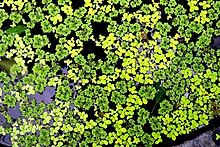Scientific Name : Azolla Filiculoides
Bahasa Indonesian : Tumbuhan Paku
Batak : Suansuanan labang aek
Basic Information:
Azolla (mosquito fern, duckweed fern, fairy moss, water fern) is a genus of seven species of aquatic ferns in the family Salviniaceae. They are extremely reduced in form and specialized, looking nothing like other typical ferns but more resembling duckweed or some mosses. Azolla filiculoides is one of just two fern species for which a reference genome has been published.[2]
Azolla is a highly productive plant. It doubles its biomass in 1.9 days or more,[9] depending on conditions, and yield can reach 8–10 tonnes fresh matter/ha in Asian rice fields. 37.8 t fresh weight/ha (2.78 t DM/ha dry weight) has been reported for Azolla pinnata in India (Hasan et al., 2009).[10]
Azolla filiculoides (red azolla) is the only member of this genus and of the family Azollaceae in Tasmania. It is a very common native aquatic plant in Tasmania. It is particularly common behind farm dams and other still water bodies. The plants are small (usually only a few cm across) and float, but can be very abundant and form large mats. The plants are typically red, and have very small water repellent leaves. Azolla floats on the surface of water by means of numerous small, closely overlapping scale-like leaves, with their roots hanging in the water. They form a symbiotic relationship with the cyanobacterium Anabaena azollae, which fixes atmospheric nitrogen, giving the plant access to the essential nutrient. This has led to the plant being dubbed a “super-plant”, as it can readily colonise areas of freshwater, and grow at great speed – doubling its biomass every two to three days. The typical limiting factor on its growth is phosphorus, another essential mineral. An abundance of phosphorus, due for example to eutrophication or chemical runoff, often leads to Azolla blooms. Unlike all other known plants, the symbiotic microorganism is transferred directly from one generation to the next. This has made Anabaena azollae completely dependent on its host, as several of its genes are either lost or has been transferred to the nucleus in Azolla’s cells.[11]
The nitrogen-fixing capability of Azolla has led to Azolla being widely used as a biofertiliser, especially in parts of southeast Asia. Indeed, the plant has been used to bolster agricultural productivity in China for over a thousand years. When rice paddies are flooded in the spring, they can be inoculated with Azolla, which then quickly multiplies to cover the water, suppressing weeds. The rotting plant material releases nitrogen to the rice plants, providing up to nine tonnes of protein per hectare per year.[12]
Azolla are weeds in many parts of the world, entirely covering some bodies of water. The myth that no mosquito can penetrate the coating of fern to lay its eggs in the water gives the plant its common name “mosquito fern”.[13], however, as noted below, it may deter the survival of some of its larvae.
Most of the species can produce large amounts of deoxyanthocyanins in response to various stresses,[14] including bright sunlight and extremes of temperature,[15][16] causing the water surface to appear to be covered with an intensely red carpet. Herbivore feeding induces accumulation of deoxyanthocyanins and leads to a reduction in the proportion of polyunsaturated fatty acids in the fronds, thus lowering their palatability and nutritive value.[17]
Azolla cannot survive winters with prolonged freezing, so is often grown as an ornamental plant at high latitudes where it cannot establish itself firmly enough to become a weed. It is not tolerant of salinity; normal plants can’t survive in greater than 1–1.6‰, and even conditioned organisms die in over 5.5‰ salinity.[18
Azolla reproduces sexually, and asexually by splitting.
Like all ferns, sexual reproduction leads to spore formation, but Azolla sets itself apart from other members of its group by producing two kinds. During the summer months, numerous spherical structures called sporocarps form on the undersides of the branches. The male sporocarp is greenish or reddish and looks like the egg mass of an insect or spider. It is two millimeters in diameter, and inside are numerous male sporangia. Male spores (microspores) are extremely small and are produced inside each microsporangium. Curiously, microspores tend to adhere in clumps called massulae.[7]
Female sporocarps are much smaller, containing one sporangium and one functional spore. Since an individual female spore is considerably larger than a male spore, it is termed a megaspore.
Azolla has microscopic male and female gametophytes that develop inside the male and female spores. The female gametophyte protrudes from the megaspore and bears a small number of archegonia, each containing a single egg. The microspore forms a male gametophyte with a single antheridium which produces eight swimming sperm.[20] The barbed glochidia on the male spore clusters cause them to cling to the female megaspores, thus facilitating fertilization.
Health Benefits:
Sources:
https://www.google.com/search?client=ubuntu&channel=fs&q=keuntungan+sehat+dari+tnanaman+azolla&ie=utf-8&oe=utf-8


2. Producing drugs – Aspidium sp, Dryopteris filix mas, and Lycopodium clavatum.
3. As vegetables: clover (marsilea crenata) and pteridium aqualium
4. As a green manure ingredient: azolla piñata,
5. As one of the ingredients in making bouquets: Lycopodium